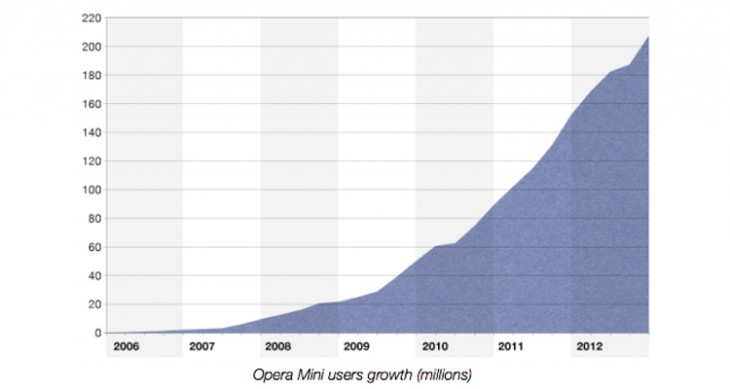
The number of people using an Internet browser built by Opera on their mobile phone is on the rise, as the Norwegian company has announced today that last month, it saw its largest increase in users since it launched Opera Mini back in 2006.
The firm has revealed that more than 208 million people were using the Opera Mini app to access the Internet in December 2012. Opera Mini is one of the company’s flagship products, as it runs on almost every major mobile operating system on the market; iOS, Android, BlackBerry and Windows Mobile, to name just a few.
Combined with the firm’s alternative app, Opera Mobile, that headline figures shoots up yet again to 229 million, representing an overall increase of more than 13 million users from November 2012. Opera Mobile, available only for Android and Symbian smartphones at the moment, is a full Internet browser that uses the company’s top web-rendering engine, Opera Presto, to download and display different web-pages.
The difference between the two is that Opera Mini opts for the company’s advanced server compression technology, essentially doing some of the heavy lifting on Opera’s own servers before sending the results to a mobile device. Although the quality of the webpage might suffer a little bit as a consequence, it means that webpages load much faster on the move and require less data; an important advantage for users in developing markets.

The company has also suggested that many of its Android users opt for Opera Mobile when they’re on a stable Wi-Fi connection, before switching to Opera Mini once they’re out of the house or on the move.
The figures have been released as part of Opera’s State of the Mobile Web report for December 2012. It says that part of the reason why the Opera browser has done so well recently is because of the increase in smartphone adoption, particularly in the Asia-Pacific and Latin America regions:
“More and more, we see Opera Mini users upgrading their handsets from basic phones to smartphones. The rise of smartphone users has been significant during the last couple of years, both on the Opera Mobile smartphone browser and the Opera Mini browser, which can be used on nearly all basic phones, as well as Android and other smartphones. Now, 32 percent of all Opera’s mobile users are on smartphones, while the rest are on non-smartphones.”
Last month, the Opera Mini servers alone, which do not process websites for the Opera Mobile users, produced more than 143 billion pages and compressed over 12 peta bytes of data. Compared with the same month in 2011, that’s a significant increase of 39 percent.
Opera isn’t just interested with mobile devices at the moment though. Towards the end of December the company partnered with Boxee, allowing the streaming media player to access its Opera Devices SDK for HMTL5 apps such as Facebook, YouTube, Spotify and Vimeo, among others.
You can also catch up on some of the past themes of Opera’s State of the Mobile Web report here.
Image Credit: Yukop / Flickr
Get the TNW newsletter
Get the most important tech news in your inbox each week.




